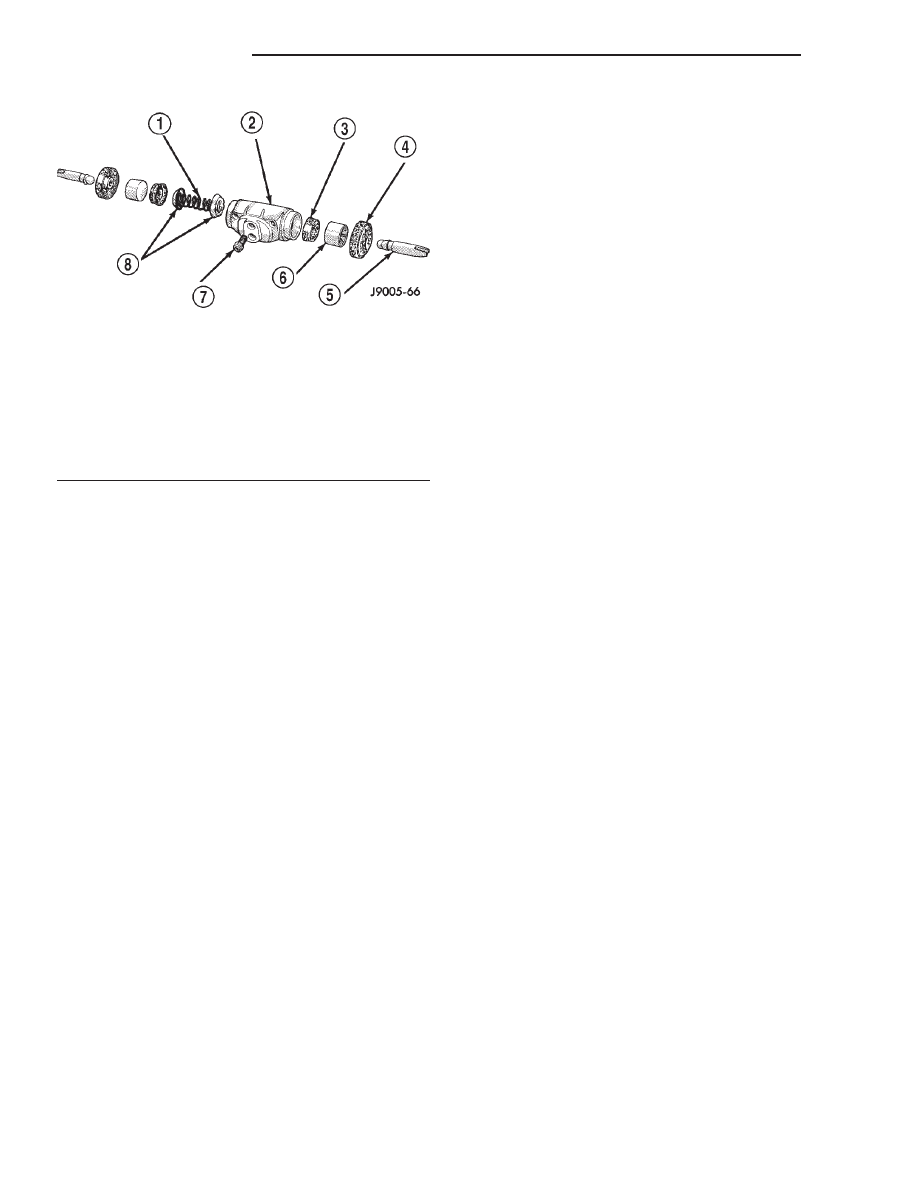Dodge Dakota (R1). Manual - part 238

INSPECTION
Inspect the cylinder bore. Light discoloration and
dark stains in the bore are normal and will not
impair cylinder operation.
The cylinder bore can be lightly polished but only
with crocus cloth. Replace the cylinder if the bore is
scored, pitted or heavily corroded. Honing the bore to
restore the surface is not recommended.
Inspect the cylinder pistons. The piston surfaces
should be smooth and free of scratches, scoring and
corrosion. Replace the pistons if worn, scored, or cor-
roded. Do attempt to restore the surface by sanding
or polishing.
Discard the old piston cups and the spring and
expander. These parts are not reusable. The original
dust boots may be reused but only if they are in good
condition.
ASSEMBLY
(1) Lubricate wheel cylinder bore, pistons, piston
cups and spring and expander with clean brake fluid.
(2) Install first piston in cylinder bore. Then
install first cup in bore and against piston. Be sure
lip of piston cup is facing inward (toward
spring and expander) and flat side is against
piston.
(3) Install
spring
and
expander
followed
by
remaining piston cup and piston.
(4) Install boots on each end of cylinder and insert
push rods in boots.
(5) Install cylinder bleed screw.
INSTALLATION
(1) Apply bead of silicone sealer around cylinder
mounting surface of support plate.
(2) Install cylinder mounting bolts and tighten to
20 N·m (15 ft. lbs.).
(3) Connect brake line to cylinder.
(4) Install brake shoe return spring.
(5) Install brake drum.
(6) Install wheel and tire assembly. (Refer to 22 -
TIRES/WHEELS/WHEELS - STANDARD PROCE-
DURE).
(7) Bleed base brake system. (Refer to 5 - BRAKES
- STANDARD PROCEDURE).
SUPPORT PLATE
REMOVAL
(1) Remove wheel and tire assembly and brake
drum.
(2) Remove brake shoe assembly. (Refer to 5 -
BRAKES/HYDRAULIC/MECHANICAL/DRUM
-
REMOVAL).
(3) Remove parking brake cable from parking
brake
lever.
(Refer
to
5
-
BRAKES/PARKING
BRAKE/CABLES - REMOVAL).
(4) Compress parking brake cable retainer tabs.
Then push retainer and cable through and out of
support plate.
(5) Disconnect brake line at wheel cylinder.
(6) Remove wheel cylinder from support plate.
(Refer to 5 - BRAKES/HYDRAULIC/MECHANICAL/
WHEEL CYLINDERS - REMOVAL).
(7) Remove axle shaft, (Refer to 3 - DIFFEREN-
TIAL & DRIVELINE/REAR AXLE - 9 1/4/AXLE
SHAFTS - REMOVAL).
(8) Remove bolts attaching support plate to axle
and remove support plate.
INSTALLATION
(1) Apply bead of silicone sealer around axle
mounting surface of support plate.
(2) Install support plate on axle flange. Tighten
attaching bolts to 115 N·m (85 ft. lbs.).
(3) Apply bead of silicone sealer around wheel cyl-
inder mounting surface and install wheel cylinder.
(Refer to 5 - BRAKES/HYDRAULIC/MECHANICAL/
WHEEL CYLINDERS - INSTALLATION).
(4) Install brake line in wheel cylinder.
(5) Install parking brake cable in support plate.
(6) Install axle shaft, (Refer to 3 - DIFFEREN-
TIAL & DRIVELINE/REAR AXLE - 9 1/4/AXLE
SHAFTS - INSTALLATION).
(7) Connect parking brake cable to lever on sec-
ondary shoe and install brake shoes on support plate.
(8) Adjust brake shoes to drum with brake gauge.
Fig. 48 Wheel Cylinder Components–Typical
1 - SPRING
2 - CYLINDER
3 - PISTON CLIP
4 - BOOT
5 - PUSH ROD
6 - PISTON
7 - BLEED SCREW
8 - CUP EXPANDERS
5 - 28
BRAKES - BASE
AN
WHEEL CYLINDERS (Continued)